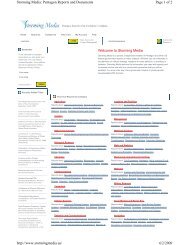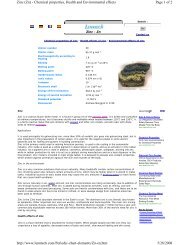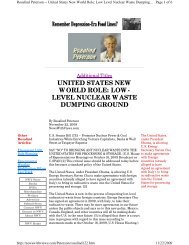of 47 ASTRONOMY CONTRAILS JET AVIATION - Agriculture ...
of 47 ASTRONOMY CONTRAILS JET AVIATION - Agriculture ...
of 47 ASTRONOMY CONTRAILS JET AVIATION - Agriculture ...
You also want an ePaper? Increase the reach of your titles
YUMPU automatically turns print PDFs into web optimized ePapers that Google loves.
<strong>ASTRONOMY</strong> <strong>CONTRAILS</strong> <strong>JET</strong> <strong>AVIATION</strong> CIRRUS GLOBAL WARMING AIR PO... Page 6 <strong>of</strong> <strong>47</strong><br />
SHUTTLE MISSION TO REGENSBERG,08/17/1943.<br />
THE THUNDERBOLTS: RAMROD TO EMDEN, 10/02/1943.<br />
WILHELMSHAVEN, 11/03/1943.<br />
GERMAN PRISONERS EVACUATED TO NAPLES; GERMAN PLANES DIVE BOMB<br />
ANZIO, ITALY: EVACUATION OF WOUNDED MARINES, 12/22/1943.<br />
MISSION TO AIRFIELD NORTH OF ROME, 01/14/1944.<br />
MISSION TO WILHELMSHAVEN, 02/03/1944.<br />
ISSION TO BERLIN, GERMANY, 03/22/1944.<br />
MISSIONS TO BERNBERG & OBERPFAFFENHEFEN, 04/13/1944.<br />
COMBAT MISSION BERCK SUR MER, FRANCE 06/02/1944.<br />
MISSION TO HAMBURG, GERMANY, 06/18/1944.<br />
MISSION TO BERNBURG, GERMANY, 06/29/1944.<br />
JAP PLANES ATTACK CARRIER AND TASK FORCE, 06/30/1944.<br />
Anti-aircraft Battery are silhouetted against German sky streaked with vapor trails from allied and enemy planes engaged in Christmas Day dog-fight. Near Puffendorf,<br />
Germany., 12/25/1944. - with unknown photo on: http://www.nara.gov/... http://www.nara.gov/...<br />
3. WWII (April 6, 1945, text only): "Two aircraft were missing as a result <strong>of</strong> a mid-air collision shortly before reaching the target at Leipzig: #43-38958, Green Hill Belle,<br />
427BS, and #44-86<strong>47</strong> (No Name), 360BS-M. The dense contrails appeared to contribute directly to the collision": http://303rdbga.com/...<br />
4. WWII St.Pauls Cathedral contrails, photo: http://gallery.yimg.com/...<br />
5. WWII (text only, there is another report also for this date): Merseburg - one <strong>of</strong> the roughest targets in the ETO! Most difficult mission was mission #275, 21 Nov. 1944;<br />
target Leuna works in Merseburg, Germany. Thick fog from 18,000 to above 28,000 feet made visual bombing impossible. PFF (Radar) bombing from 18,000 feet was<br />
ineffective and also exposed the group to murderous accurate flak. Thick contrails obscured vision and made tight formation impossible. As it was, Lt. Green's plane<br />
collided with Lt. Virag's ship sending him down where ME-109s finished the job. Many ships dropped bombs when they saw others salvo, resulting in a scattered drop<br />
and in no way accurate.:" http://www.303rdbga.com/...<br />
6. WWII (text only): "5th April 1945 (Mission 158) AC 43-38286 (Flying Dutchmen), Don McCutchan, 7th Squadron Unterschlauersbach ( 10 miles W <strong>of</strong> Nurnburg) 5<br />
April, jet airfield shocked by our 2 ship formation. Very bad weather, 25,000 ft clouds, dense persistent contrails, assembly impossible. Back over Belgium at 800 ft 7 1/2<br />
hrs , 900 miles": http://www.jccc.net/...<br />
7. Check for redundancy: WWII (Nov 21, 1944, text only): "Meyer maneuvered his formation into position for a surprise attack, himself shooting down three FW-190s. In<br />
one case, he used the contrail <strong>of</strong> an FW-190 for cover, firing at the unseen enemy until he could see strike flashes through the contrail, then breaking <strong>of</strong>f just before<br />
ramming the burning enemy plane": http://acepilots.com/...<br />
8. WWII memories, February 3, 1945, over Berlin, with contrails; text only: http://www.dhm.de/...<br />
9. WWII (text only): " As you've assumed, the bomber crews as well as our fighter escort saw contrails about every day even though an effort was made to avoid them. As<br />
was <strong>of</strong>ten said, they represented large fingers pointing to the bombers. Obviously <strong>of</strong> assistance to the enemy fighters who could spot us at a considerable distance. The<br />
nature <strong>of</strong> the contrails was such that they required certain atmospheric conditions to form. Thus, they were principally affected by altitude. At the pre-mission briefings,<br />
they typically advised us <strong>of</strong> the altitude that the formation <strong>of</strong> contrails could be expected with an effort made to avoid that particular altitude. More <strong>of</strong>ten than not<br />
though, we did in fact make contrails indicating that their information was faulty or that flying at that altitude couldn't be avoided. We in B-24s typically bombed from<br />
about 22,000 feet while the B-17s, which could fly higher, bombed from around 27,000, particularly at tough targets where higher was better in an effort to avoid the flak<br />
as much as possible. My recollection is that the contrails persisted for some time. While I don't recall timing them, I would guess that they could be seen for fifteen<br />
minutes or more. At times, Germany appeared to be almost covered by contrails as far as you could see. Essentially creating a cloud layer which could possibly persist<br />
for hours I suppose. The bombers' in more or less straight lines, the fighters', usually above us, more random as they criss crossed or circled. A common sight was the<br />
escorts dropping their tanks and heading <strong>of</strong>f after the bad guys. The contrails also tended to create a cloud layer which restricted the visibility <strong>of</strong> the following aircraft.<br />
So, contrails represented a problem to us and were to be avoided if at all possible": http://www.ecotoday.com/...<br />
10. Doublet? Contrails and flak, WWII: http://www.secretvietnamwar.com/...<br />
KOREAN WAR ... up<br />
1. 1950: "As we moved nearer to the target, I spotted contrails across the river. For the past thirty minutes there had not been one word on the radio, and then, I heard<br />
loud and clear; "Bandits at ten o'clock, coming in." Immediately the throttles went to 100% and the dog fight was on": http://www.onr.com/user/dtg/Chapter1.htm<br />
2. 1953: "For one thing, Red interceptors were locating the B29s by trailing their contrails on moonlit nights. Such nights were now avoided":<br />
http://www.airpower.maxwell.af.mil/...<br />
3. "Darkness no longer afforded B-29s protection to attack targets in North Korea; enemy night interceptors shot down four B-29s in January. The enemy used ground<br />
radar to guide interceptors to the medium bombers; moonlight, contrails, searchlights, and flares for visual identification; and controller aircraft for coordination <strong>of</strong><br />
fighter passes": http://www.au.af.mil/...<br />
4. "The Fifth Air Force joined the Navy and Marines to provide fighter escorts to intercept enemy aircraft before they could attack the B-29s. Bomber Command also<br />
restricted.missions along the Yalu to cloudy, dark nights because on clear nights contrails gave away the bombers' positions": http://www.maxwell.af.mil/...<br />
5. "I recall the specifics <strong>of</strong> the route <strong>of</strong> flight and the actual flying <strong>of</strong> the mission itself, but do not recall the escorters. Typically, there was the rendezvous over Chinampo<br />
Peninsula, normally SOP for long range reconnaissance, the calling <strong>of</strong>f <strong>of</strong> MiG trains leaving the station as reported by "Stovepipe Control" and the F-86s weaving<br />
overhead as escorts. Far ahead in the skies over China, the tiny silver dots and contrail streamers would start to form as the Migs climbed up through contrail altitude.<br />
Contrails over North Korea/China start to form at about 28,000 feet and quit forming at about 34,000 feet in the late fall and winter time. A defensive measure/bit <strong>of</strong><br />
information well worth knowing. It makes an airplane harder to see if they ain't pulling contrails. You either fly above or below the contrail level":<br />
http://www.cottonpickers.org/...<br />
6. "1953 Jan. 10/11: 307th BW B-29s bombed Sonchon and Anju marshaling yards. Enemy searchlights illuminated a B-29 apparently betrayed by its contrails, and<br />
fighters shot it down": http://www.afa.org/...<br />
7. "Another reason for the friction was that <strong>of</strong>ten the F-86s were supposed to provide a MiG cap to protect the Fighter Bombers from attack during their bombing runs.<br />
The F-86s were sitting at 30,000 feet watching for contrails from the north. Unfortunately, the seasoned Russian pilots simply came in low without any tell-tale contrail<br />
and attacked the heavily laden F-84s": http://kalanio.tripod.com/...<br />
8. "We were to have a major setback at this point. When we got to high altitude and started leaving contrails, the contrails totally obscured the view-finder in the rear<br />
compartment. I couldn't see a thing. We had never left contrails on any <strong>of</strong> our practice flights so were not aware <strong>of</strong> the problem": http://www.rb-29.net/...<br />
FRENCH INDOCHINA WAR ... up<br />
1. Air War over French Indochina (text only, 1954): "Although the airstrike never came to fruition, USN aircraft did fly reconnaissance missions in support <strong>of</strong> the possible<br />
strike, and forces on the ground at DBP [Dien Bien Phu] reported sighting jet contrails high in the sky ": http://www.hedgehoghollow.com/...<br />
COLD WAR ... up<br />
1. "Telltale Contrails: Normally the flights were a quick loop, overflying targets near Vladivostok and Sakhalin in the Soviet Far East. Between April 1954 and February<br />
1955, USAF pilots conducted nine missions, usually comprising four aircraft flying at altitudes from 45,000 to 48,000 feet. They knew they would be tracked by Soviet<br />
radar but <strong>of</strong> greatest concern were the aircraft contrails that pinpointed their location:" http://www.afa.org/...<br />
2. Cold War (1954): "It was a clear day (not a cloud in the sky) as we coasted in to the Soviet Union. Suddenly we started to generate contrails like six white arrows<br />
pointing to our airplane. (Not in the forecast!) As we passed over our first recon target I could see the fighters circling up to meet us and knew it would only be a matter<br />
<strong>of</strong> time before they reached our altitude" (text only): http://nerd.dartmouth.edu/...<br />
3. Probably before 1962: An apparent contrail over the old BMEWS installation at Thule Air Base: http://www.bwcinet.com/...<br />
VIETNAM WAR ... up<br />
http://www.astro.ku.dk/~holger/IDA/notes.html<br />
12/11/2008











